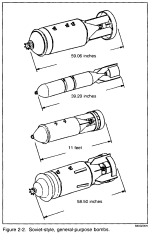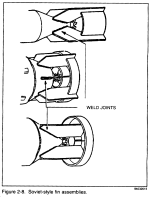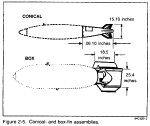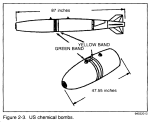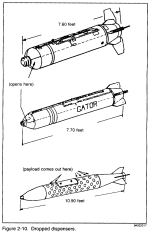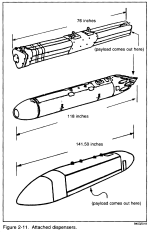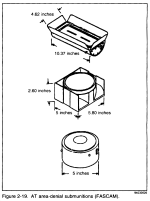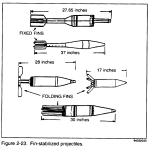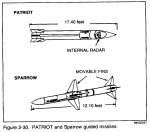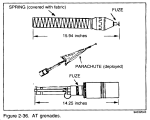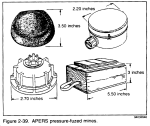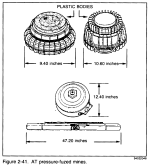Unexploded Ordnance (UXO)*
"Don't pick up anything that you did not drop."
| Those working in a military environments will
occasionally encounter unexploded ordnance.
Some of this ordnance is visually obvious and easily recognized.
Some is not so obvious and may appear harmless. |
 |
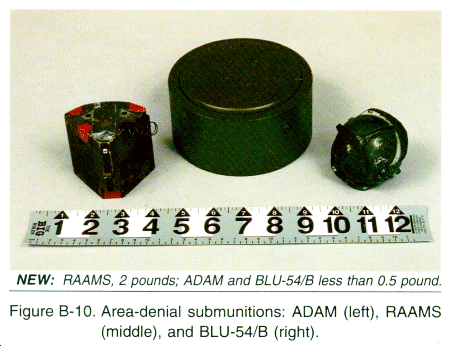
In either case, it is important to be able to recognize UXO, and know how to
deal with it safely.
Basic Safety Guidelines:
- Do not continue to move towards a suspected UXO. Some types of ordnance
have magnetic or motion-sensitive fuzing and will not detonate until they
sense a target. Others may have self-destruct timers built in.
- Make all radio transmissions at least 100 meters away from a UXO hazard.
When transmitting, radios send out electricity from their antennas. This
electricity can make a UXO blow up.
- Do not try to remove anything that is on or near a UXO. Your actions could
make the UXO blow up.
- Do not move or disturb a UXO.
- Stay away from UXOs. This is the best way to prevent accidental
injury or death.
- Mark a UXO hazard area properly so that other personnel will stay away
from it.
- Evacuate all nonessential personnel and equipment from a UXO hazard area.
If personnel and equipment cannot be evacuated, you must take protective
measures to reduce the risk to them.
- Report through your chain of command all UXO hazards that affect your
operations. Reporting UXO hazards will get your unit the help it
needs.
- If necessary, extract the unit from a hazardous area.
Recognition of Unexploded
Ordnance:
Once a UXO is identified:
- If at all possible, avoiding or bypassing the UXO hazard is the safest
option to take for personnel and equipment.
- If the UXO hazard is left from a recent enemy attack, you must consider
protecting your personnel and equipment by extracting them from the area
before another attack is targeted on you.
- If the hazard cannot be avoided/bypassed, protective measures must be
taken to reduce the hazard to personnel and equipment.
- Regardless of the option you choose, the location of the UXO must be
clearly marked with UXO markers and the hazard reported to your next higher
headquarters.
| Evacuation:
Evacuate all non-essential personnel far enough away from the UXO to
reasonably protect them.
This chart gives some guidance in determining safe evacuation
distances.
If a protective barrier is erected, shorter distances can be
used. |
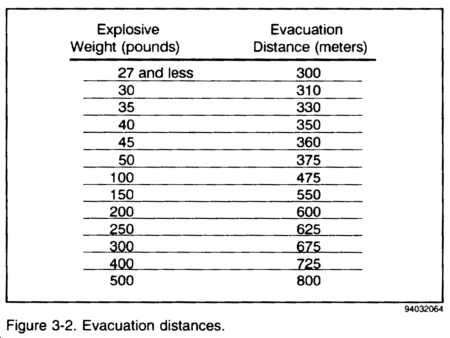 |
Isolation
Sometimes, for mission-related, operational, or other reasons, you cannot
evacuate personnel and/or equipment or you cannot leave a particular area. When
this happens, you must isolate either your assets (personnel, equipment, and
operations) from the UXO or isolate the UXO from your assets.
Barricade
A barricade is an artificial barrier that provides limited protection by
channeling the blast and fragmentation from the threatened area. Barricades may
also be used to lessen the effect of the blast and to reduce the size of the
evacuation area. Building artificial barricades is very time consuming and
requires a large number of sandbags. Depending on the size of the UXO,
barricades can be built around the UXO to protect the entire area, or they can
be built next to the equipment or areas that cannot be evacuated.
| The barricade should be built no closer to the
UXO than the height for the barricade plus 3 feet.
For example, the barricade shown in this drawing is 5 feet tall. By
adding an additional 3 feet, the barricade is built no closer than 8 feet
to the UXO. |
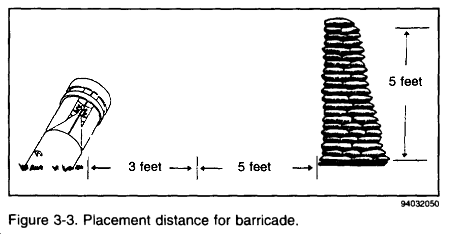 |
| When possible, build the barricade between the
building and/or the equipment to be protected and the UXO.
By positioning the barricade in this location, personnel who are in or
around the building or who are using the equipment will be afforded the
greatest protection from the blast and flying fragments. |
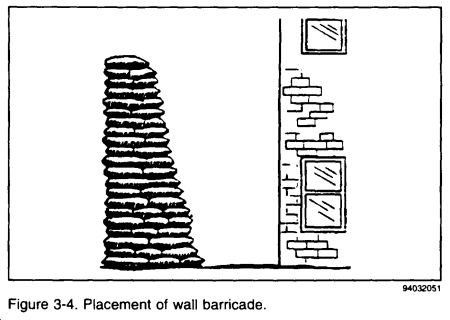 |
| When building a barricade, the sandbags must
be interlocked for stability.
Sandbags that are not interlocked will reduce protection and make the
barricade unstable. |
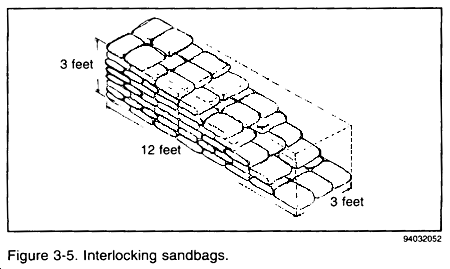 |
| For small UXOs such as missiles and rockets
less than 70 millimeters in diameter, for projectiles less than 75
millimeters in diameter, and for submunitions and grenades, a doublewall
thickness of sandbags should surround the area of the UXO.
The sandbags must be stacked to a height of at least 3 feet and should
be thick enough to protect personnel and equipment from the blast and
fragmentation. |
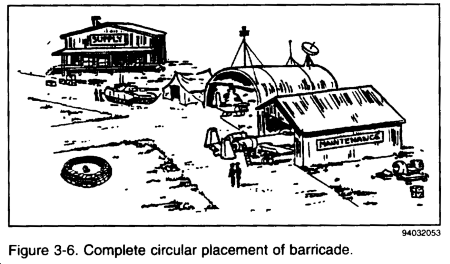 |
| A circular barricade is the best
choice for small UXO hazards, because it provides complete protection for
personnel and equipment. A circular barricade that is 8 feet in diameter,
3 feet tall, and 3 sandbags thick would require approximately 400
sandbags. The circular barricade shown above will force the blast and
fragmentation upward. |
| For medium-sized UXOs such as missiles,
rockets, and projectiles up to 200 millimeters in diameter, and for
large-sized placed munitions on the surface, a four-or five-wall thickness
of sandbags should surround the area.
The sandbags must be stacked to a height of at least 5 feet in order to
protect assets. This type of barricade is usually semicircular.
It will channel the blast and fragmentation through the open side and
away from the protected area. |
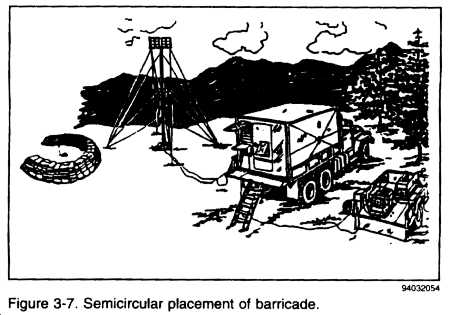 |
| Large UXOs such as projectiles, missiles, and
general-purpose bombs are too large for effective barricades to be built
around them.
In these cases, equipment and personnel activity areas would need to be
barricaded. A wall barricade between the affected area and the UXO hazard
provides the best and easiest protection.
The number of wall barricades you need will depend on how much
equipment or how many personnel you must protect. A wall barricade that is
12 feet long, 6 feet high, and 3 sandbags thick would require 700
sandbags.
The barricade should extend beyond and be at least as tall as the
equipment or personnel areas to be protected. Equipment that is barricaded
must still be usable. For example, the radar shown here must be left
exposed in order to function. |
 |
Marking the UXO Hazard
| UXO hazards are marked using
triangular signs, if available, that by their background color indicate
the danger involved.
The standard UXO marker is shown here. The background is red with a
white bomb inset. It has the same dimensions as the other markers.
|
 |
| The UXO marker is placed above
ground at waist level (about 3 feet) with the bomb pointing down.
The marker should be placed no closer to the hazard than the point
where you first recognized the UXO hazard. The marker should be attached
to a stake, a tree, or other suitable holder.
Just be sure that the marker is clearly visible. |
 |
| Mark all logical approach routes
to the area.
For example, if the hazard is near a road, as a minimum, put a marker
on each side of the road approaching the UXO. If there is a large
concentration of UXO hazards such as submunitions, mark the area as you
would a scatterable minefield, with markers placed about every 15 meters
around the area.
As a general rule, the UXO hazard itself must be easily seen from any
of the markers. This helps to keep others away from the hazard. It also
helps the EOD team to find the hazard. |
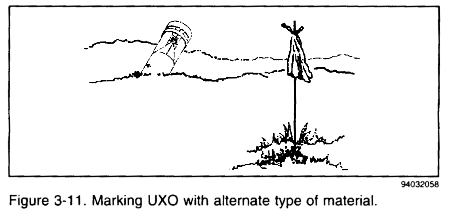 |
| If standard UXO
markers are not available, you may use other suitable materials (such as
engineer tape or colored ribbons). Ensure that the same color is used to
avoid confusion.
When using other materials, the same principles used for the standard
markers apply for placement of the makeshift markers. That is, they should
be placed about 3 feet off the ground and easily seen from all approach
routes. |
Reporting the UXO
The UXO spot report is a detailed, swift, two-way reporting system that makes
clear where the UXO hazard areas are, what their priorities are, and which units
are affected by them. The report is used to request help in handling a UXO
hazard that is beyond a unit’s ability to handle and that affects the unit’s
mission. This report helps the commander set priorities based on the battlefield
situation.
The UXO spot report is the first-echelon report that is sent when a UXO is
encountered. The report consists of nine lines. The information must be
sent by the fastest means available and the required information provided in the
following order:
| Line 1. |
Date-Time Group: DTG item was discovered. |
| Line 2. |
Reporting Activity (unit identification code
[UIC]) and location (grid of UXO). |
| Line 3. |
Contact Method: Radio frequency, call sign,
point of contact (POC),and telephone number. |
| Line 4. |
Type of Ordnance: Dropped, projected, placed,
or thrown. If available, supply the subgroup. Give the number of items,
if more than one. |
| Line 5. |
NBC Contamination: Be as specific as
possible. |
| Line 6. |
Resources Threatened: Report any equipment,
facilities, or other assets that are threatened. |
| Line 7. |
Impact on Mission: Provide a short
description of your current tactical situation and how the presence of
the UXO affects your status. |
| Line 8. |
Protective Measures: Describe any measures
you have taken to protect personnel and equipment. |
| Line 9. |
Recommended Priority: Recommend a priority
for response by EOD technicians or engineers. |
| Immediate |
Stops the unit’s maneuver and mission
capability or threatens critical assets vital to the mission. |
| Indirect |
Slows the unit’s maneuver and mission
capability or threatens critical assets important to the mission. |
| Minor |
Reduces the unit’s maneuver and mission
capability or threatens noncritical assets of value. |
| No Threat |
Has little or no affect on the unit’s
capabilities or assets. |
A priority of "Minor" or "No Threat" does not mean that the UXO is not dangerous.
*Much of the material for this chapter was taken from FM 21-16 (FMFM 13-8-1,
"Unexploded Ordnance (UXO) Procedures"
Home
· Military Medicine
· Sick Call · Basic Exams
· Medical Procedures
· Lab and X-ray · The Pharmacy
· The Library · Equipment
· Patient Transport
· Medical Force
Protection · Operational Safety · Operational
Settings · Special
Operations · Humanitarian
Missions · Instructions/Orders · Other Agencies · Video Gallery
· Forms · Web Links · Acknowledgements
· Help · Feedback
Approved for public release;
Distribution is unlimited.
Bureau of Medicine and Surgery
Department of the Navy
2300 E Street NW
Washington, D.C
20372-5300 |
Operational Medicine
Health Care in Military Settings
CAPT Michael John Hughey, MC, USNR
NAVMED P-5139
January 1, 2001 |
United States Special Operations
Command
7701 Tampa Point Blvd.
MacDill AFB, Florida
33621-5323 |
*This web version is provided by The Brookside Associates, LLC. It contains
original contents from the official US Navy NAVMED P-5139, but has been
reformatted for web access and includes advertising and links that were not
present in the original version. The medical information presented was reviewed and felt to be accurate in 2001. Medical knowledge and practice methods may have changed since that time. Some links may no longer be active. This web version has not been approved by the
Department of the Navy or the Department of Defense. The presence of any
advertising on these pages does not constitute an endorsement of that product or
service by either the US Department of Defense or the Brookside Associates. The
Brookside Associates is a private organization, not affiliated with the United
States Department of Defense.
© 2015, Brookside Associates, LLC. All rights reserved
Other Brookside Products

|
|




